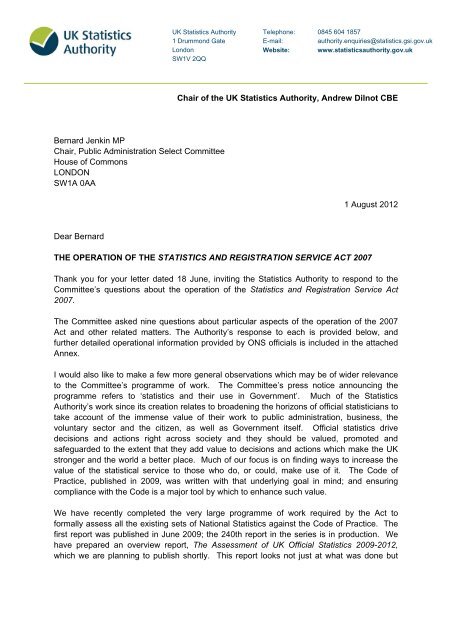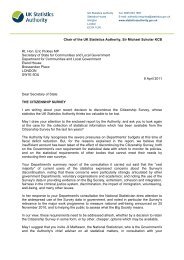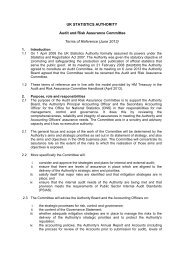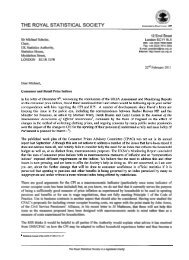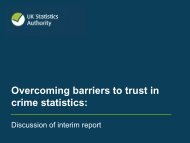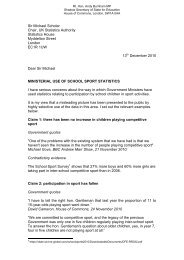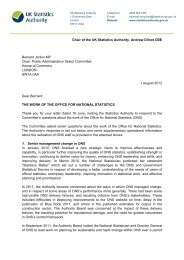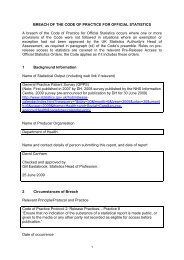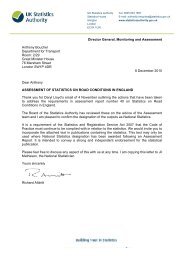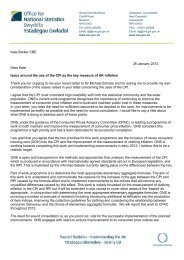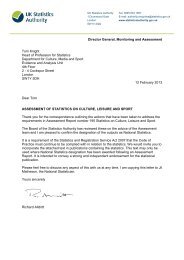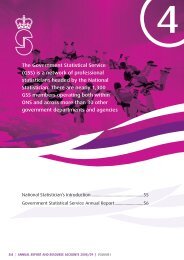Letter from Andrew Dilnot to Bernard Jenkin MP 010812
Letter from Andrew Dilnot to Bernard Jenkin MP 010812
Letter from Andrew Dilnot to Bernard Jenkin MP 010812
Create successful ePaper yourself
Turn your PDF publications into a flip-book with our unique Google optimized e-Paper software.
UK Statistics Authority<br />
1 Drummond Gate<br />
London<br />
SW1V 2QQ<br />
Telephone: 0845 604 1857<br />
E-mail:<br />
authority.enquiries@statistics.gsi.gov.uk<br />
Website: www.statisticsauthority.gov.uk<br />
Chair of the UK Statistics Authority, <strong>Andrew</strong> <strong>Dilnot</strong> CBE<br />
<strong>Bernard</strong> <strong>Jenkin</strong> <strong>MP</strong><br />
Chair, Public Administration Select Committee<br />
House of Commons<br />
LONDON<br />
SW1A 0AA<br />
1 August 2012<br />
Dear <strong>Bernard</strong><br />
THE OPERATION OF THE STATISTICS AND REGISTRATION SERVICE ACT 2007<br />
Thank you for your letter dated 18 June, inviting the Statistics Authority <strong>to</strong> respond <strong>to</strong> the<br />
Committee’s questions about the operation of the Statistics and Registration Service Act<br />
2007.<br />
The Committee asked nine questions about particular aspects of the operation of the 2007<br />
Act and other related matters. The Authority’s response <strong>to</strong> each is provided below, and<br />
further detailed operational information provided by ONS officials is included in the attached<br />
Annex.<br />
I would also like <strong>to</strong> make a few more general observations which may be of wider relevance<br />
<strong>to</strong> the Committee’s programme of work. The Committee’s press notice announcing the<br />
programme refers <strong>to</strong> ‘statistics and their use in Government’. Much of the Statistics<br />
Authority’s work since its creation relates <strong>to</strong> broadening the horizons of official statisticians <strong>to</strong><br />
take account of the immense value of their work <strong>to</strong> public administration, business, the<br />
voluntary sec<strong>to</strong>r and the citizen, as well as Government itself. Official statistics drive<br />
decisions and actions right across society and they should be valued, promoted and<br />
safeguarded <strong>to</strong> the extent that they add value <strong>to</strong> decisions and actions which make the UK<br />
stronger and the world a better place. Much of our focus is on finding ways <strong>to</strong> increase the<br />
value of the statistical service <strong>to</strong> those who do, or could, make use of it. The Code of<br />
Practice, published in 2009, was written with that underlying goal in mind; and ensuring<br />
compliance with the Code is a major <strong>to</strong>ol by which <strong>to</strong> enhance such value.<br />
We have recently completed the very large programme of work required by the Act <strong>to</strong><br />
formally assess all the existing sets of National Statistics against the Code of Practice. The<br />
first report was published in June 2009; the 240th report in the series is in production. We<br />
have prepared an overview report, The Assessment of UK Official Statistics 2009-2012,<br />
which we are planning <strong>to</strong> publish shortly. This report looks not just at what was done but
what was found during the assessment programme, the value of assessment, and how we<br />
are planning <strong>to</strong> build on this work in the future.<br />
The view of the Statistics Authority is that the 2007 Act is working reasonably well as a<br />
statu<strong>to</strong>ry framework. We have needed <strong>to</strong> complement it with quite extensive non-statu<strong>to</strong>ry<br />
arrangements that clarify and develop the Act’s provisions but there are relatively few areas<br />
in which the drafting of the legislation presents major problems; and quite a number where it<br />
has proved itself a robust platform for our work. There remain some questions about<br />
whether more far reaching statu<strong>to</strong>ry provisions in some areas – for example on ONS’s<br />
access <strong>to</strong> data <strong>from</strong> other parts of government for statistical purposes, and possibly on prerelease<br />
access arrangements – would help <strong>to</strong> ensure further efficiency and public<br />
confidence. There are also some sections of the legislation that may require a degree of<br />
interpretation – such as obligation <strong>to</strong> assess and re-assess every single set of National<br />
Statistics. The Authority will continue <strong>to</strong> raise such matters, including with the Committee,<br />
but none is so urgent as <strong>to</strong> be the centre-piece of our evidence here.<br />
Turning <strong>to</strong> the Committee’s questions:<br />
1. Promoting and safeguarding official statistics; ensuring their quality and integrity<br />
The quality of official statistics needs <strong>to</strong> be considered in the context of their eventual use.<br />
Through its reports and engagement activities, the Authority has put emphasis on asking<br />
government statisticians <strong>to</strong> explore the use made of their statistics and <strong>to</strong> assess and <strong>to</strong><br />
improve statistical quality <strong>from</strong> the user perspective.<br />
It would be premature <strong>to</strong> conclude that the goal of ensuring quality has been fully achieved.<br />
However, it is increasingly clear <strong>from</strong> the portfolio of Assessment Reports that, in the vast<br />
majority of cases, the sets of statistics that we have reviewed are both needed, and<br />
adequate for a wide range of important purposes. In that sense these official statistics are of,<br />
at least, satisfac<strong>to</strong>ry quality. However, in some other cases there are questions remaining,<br />
either due <strong>to</strong> a lack of clarity about the use of the statistics or about their suitability for<br />
particular purposes. We are continuing <strong>to</strong> explore those questions with the bodies<br />
responsible.<br />
The integrity of official statistics can be considered in terms of whether they are impartially<br />
presented and well explained at the time of release, without interference or political<br />
exploitation in advance of the statistical release. The Authority believes that the<br />
professionalism of government statisticians, firmly supported by the Code of Practice, has<br />
proved <strong>to</strong> be an effective bulwark against any inappropriate pressure on the public<br />
presentation by the professional statisticians of the statistics themselves.<br />
The decentralised nature of the UK official statistics system means that many government<br />
statisticians actively work alongside colleagues responsible for the implementation of<br />
government policy, and we have seen some signs of inhibition in terms of the advice for<br />
users included in the published statistical releases. The Authority’s position is clear on this.<br />
If there are weaknesses or limitations in the statistics, these need <strong>to</strong> be fully explained<br />
regardless of whether that makes them more or less welcome <strong>to</strong> colleagues in government.<br />
Ultimately, integrity requires the statisticians responsible for statistics <strong>to</strong> give the user all the<br />
impartial help they can; and <strong>to</strong> provide that same advice and insight whatever the policy<br />
goals of the government. This is an ongoing agenda of real importance.
The main changes in the practices <strong>to</strong> promote and safeguard statistics relate, firstly, <strong>to</strong> the<br />
expectations of the Code of Practice for Official Statistics and, secondly, <strong>to</strong> the Pre-Release<br />
Access <strong>to</strong> Official Statistics Orders (considered further below). The Code of Practice raises<br />
the standard required in many respects, and the process of ensuring compliance by means<br />
of formal assessment further ensures a shared interpretation. The elements of the Code that<br />
seem <strong>to</strong> have been most challenging <strong>to</strong> producer bodies include the requirements <strong>to</strong>:<br />
investigate and document the needs of users of official statistics, the use made of<br />
existing statistics and the types of decisions they inform;<br />
provide information on the quality and reliability of statistics in relation <strong>to</strong> the range of<br />
potential uses;<br />
prepare and disseminate commentary and analysis that aid interpretation, and<br />
provide factual information about the policy or operational context of official statistics;<br />
adopt systematic planning arrangements, including transparent priority setting, that<br />
reflect the obligation <strong>to</strong> serve the public good; and,<br />
promote comparability within the UK and internationally by, for example, adopting<br />
common standards, concepts...definitions, statistical units and classifications.<br />
These and other requirements of the Code lead directly <strong>to</strong> changes in the practices <strong>to</strong><br />
promote and safeguard official statistics. We believe that in this and other ways the Authority<br />
is causing already good statistical practice <strong>to</strong> change for the better.<br />
2. Improvement in public confidence in official statistics; changing user experience<br />
The Statistics Authority commissioned and published a report by the National Centre for<br />
Social Research (NatCen) in June 2010. The report updated earlier research and concluded<br />
that ‘when asked whether (respondents) thought that official statistics are produced without<br />
political interference, the majority (59%) disagreed; (and) a similar proportion (60%)<br />
disagreed that the government presents official figures honestly when they talk about their<br />
policies’. The report also noted that ‘views about the government and the media were very<br />
similar, with the same proportion (61%) disagreeing that newspapers present official<br />
statistics honestly.’<br />
In relation <strong>to</strong> the accuracy of official statistics, the report observed that ‘about a third of<br />
people agreed that official statistics were accurate while 40 per cent disagreed.’ The report<br />
associated perceptions of accuracy of official statistics with three fac<strong>to</strong>rs – age (of the<br />
respondent), levels of understanding of official statistics, and levels of trust in the<br />
government. Those aged over 35, with less understanding of official statistics, and with<br />
lower levels of trust in government, were the most likely <strong>to</strong> doubt accuracy.<br />
Public confidence remains a matter of concern <strong>to</strong> the Statistics Authority, but we note the<br />
findings of this research that public confidence in official statistics seems <strong>to</strong> be associated<br />
with wider public attitudes <strong>to</strong> government and <strong>to</strong> the news media.<br />
Alongside the 2010 report on public confidence in official statistics, the Authority also<br />
commissioned and published a report by IpsosMori which was based on more in-depth<br />
interviews with some 60 leading users of statistics and other ‘opinion formers’. The<br />
IpsosMori report concluded that ‘generally, official statistics were viewed positively…because<br />
they provide an evidence base, and are also useful in holding both politicians and<br />
government <strong>to</strong> account’. Also, that ‘(official statistics) allow others, including opposition
parties, <strong>to</strong> lobby for change, and are emblematic of an honest and transparent system of<br />
governance’.<br />
The Authority is not surprised that the <strong>to</strong>ne of the two reports is different. We understand<br />
that the general public are largely dependent on the news media for information about official<br />
statistics and, in that context, all sorts of statistics – official and <strong>from</strong> other sources – are<br />
conflated and commented on, often in sweeping and adversarial terms. Those individuals<br />
and groups that we identify as ‘opinion-formers’ tend <strong>to</strong> use official statistics and make<br />
professional comment on them, and are thus more likely <strong>to</strong> identify the utility and relevance<br />
of the specific statistical product.<br />
However, we also believe that attitudes <strong>to</strong> official statistics, both among the general public<br />
and among the leading commenta<strong>to</strong>rs, will change only slowly and will be influenced by the<br />
statistical product itself, the confidence of journalists in the service they receive, and by the<br />
reputation of the Statistics Authority as an effective promoter of good practice.<br />
It is clearly important that there should be public confidence in official statistics, as without<br />
that trust, the statistics are unlikely <strong>to</strong> be used as beneficially as possible. In effect, trust is a<br />
prerequisite for utility. However, the intrinsic trustworthiness of the statistics is similarly a<br />
prerequisite for trust. Trustworthiness means that the statistics should be the right statistics<br />
<strong>to</strong> be collected and published, produced by the right methods and explained fully and frankly<br />
<strong>to</strong> those who would use them. The Authority’s statu<strong>to</strong>ry assessment regime is designed <strong>to</strong><br />
ensure trustworthiness through compliance with the Code of Practice.<br />
On the question of the user experience, the Authority would hope that users of official<br />
statistics will recognise improvements in the public explanation of the statistics, and their<br />
accessibility, at the time of first release. The Authority has publicly supported the<br />
Government’s Open Data initiative and we have worked closely with the Royal Statistical<br />
Society <strong>to</strong> support the Statistics User Forum and its new online Statistics User Network. This<br />
user network offers all users of official statistics a route <strong>to</strong> exchange information with other<br />
users and <strong>to</strong> seek information and advice <strong>from</strong> government statisticians.<br />
3. Authority’s organisational structure; dual roles of producer and regula<strong>to</strong>r<br />
The Statistics Authority believes that the statu<strong>to</strong>ry framework introduced by the 2007 Act is<br />
an effective one; albeit one that needs careful explanation <strong>to</strong> those unfamiliar with it. The<br />
Board comprises eight non-executive direc<strong>to</strong>rs, including the Chair and two deputy chairs,<br />
alongside three executive members, and works as a single corporate entity. In addition, the<br />
Authority Board members organise themselves in <strong>to</strong> two sub-groups under the respective<br />
supervision of the two deputy chairs. One of these groups is responsible for the Authority’s<br />
work in promoting and safeguarding the production and publication of all UK official statistics,<br />
wherever produced, and for good practice in the use of official statistics. The other is<br />
responsible for the governance and oversight of ONS. Each lets the other perform its role<br />
unhindered, subject <strong>to</strong> full oversight of both areas by the Authority Board in plenary.<br />
There are inevitably challenges in labelling the various parts and roles. The 2007 Act uses<br />
the phrase ‘Statistics Board’ in different sections of the Act <strong>to</strong> mean different things, ranging<br />
<strong>from</strong> the eight non-executive members <strong>to</strong> the whole statu<strong>to</strong>ry entity of over 3,500 people. It<br />
is not always clear which usage is intended. To fulfil part of its statu<strong>to</strong>ry role, the Authority<br />
publishes reports which raise questions and proposals about work done within ONS. The
separation of roles is well unders<strong>to</strong>od by Authority staff; and those who are involved in<br />
producing such reports are not involved in deciding the response.<br />
We have provided further information about the Authority’s oversight of ONS in our response<br />
<strong>to</strong> the Committee’s separate study of the work of the ONS.<br />
4. Data sharing and confidentiality powers<br />
In general, the data sharing and confidentiality provisions of the 2007 Act have improved<br />
ONS’s ability <strong>to</strong> obtain administrative data, and <strong>to</strong> protect the confidentiality of those data.<br />
There have been five data sharing Orders under the Act so far which are helping <strong>to</strong> lead <strong>to</strong><br />
improved statistics, reduced burden on respondents, and reduced operational costs <strong>to</strong> ONS<br />
in the longer term. The Approved Researcher gateway, provided for in the 2007 Act, is<br />
currently used by about 2,000 researchers, who are allowed <strong>to</strong> access data for legitimate<br />
research purposes that were previously not available <strong>to</strong> them.<br />
However, there are some weaknesses. For example, the 2007 Act only permits data sharing<br />
between the ONS and another public authority. Data sharing gateways, once they are<br />
created, permit sharing of data but do not create any obligation on the part of the data owner<br />
<strong>to</strong> cooperate with ONS. Data sharing Orders specify the purpose for the sharing of data, the<br />
source of the data, and the data variables <strong>to</strong> be shared. We are <strong>to</strong>ld that these criteria<br />
present difficulties for complex datasets. These are technical points but inhibit the original<br />
intention of freeing up the exchange of data for statistical purposes. The Authority will want<br />
<strong>to</strong> pursue how best <strong>to</strong> overcome the obstacles and may consider preparing a report on the<br />
experience in this area since the legislation was introduced.<br />
5. Costs of Code compliance and assessment; cost reduction<br />
The Code of Practice is wide ranging but mostly requires no more than the good practice that<br />
good managers would seek <strong>to</strong> achieve without the Code. Ensuring Code compliance may<br />
involve some costs but it also enhances value. Compliance with the Code confers real<br />
benefits on both the user of statistics and the producer. It assures the user that high<br />
standards have been observed and it gives the producer organisation added credibility and<br />
authority.<br />
In May 2011 the Authority published its report on The impact of the Authority’s Moni<strong>to</strong>ring<br />
and Assessment Function, which considered the emerging evidence on the benefits<br />
associated with the Code and the assessment regime. It concluded that some improvements<br />
were identifiably the direct result of an assessment report; others might have been driven by<br />
messages emerging <strong>from</strong> the assessment process more generally, or made in anticipation of<br />
future assessment. And in some cases assessment may simply have accelerated an<br />
improvement already in train.<br />
The Statistics Authority’s view is that the first programme of assessment has been<br />
successful. It prompted a large number of detailed improvements in statistical products and<br />
the statistical service; it gathered evidence of the need <strong>to</strong> make further improvements; and it<br />
documented the characteristics of the UK statistical service more thoroughly than we have<br />
seen in any other country.<br />
The first programme cost an average of £1.5 million per annum – mostly staff and central<br />
services costs for a team of up <strong>to</strong> 20 people. While the long-term benefits are still <strong>to</strong> be fully<br />
realised, we note that the <strong>to</strong>tal cost of statistical activity across government runs <strong>to</strong> hundreds
of millions of pounds a year and that assessment represents less than half of one per cent of<br />
the cost of government statistical work.<br />
More specifically, we already see improvements associated with assessment in a number of<br />
areas, for example:<br />
<br />
<br />
better research and understanding of the use made of statistics – which is essential in<br />
order <strong>to</strong> judge quality and guide future development of statistical products (releases,<br />
reports etc);<br />
improved dialogue between government statisticians and users of statistics outside<br />
the producer organisation; and,<br />
the quality and accessibility of statistical products, particularly statistical releases<br />
which mark the issue of new statistical data – these are the ‘shop window’ of the<br />
statistical service and thus central <strong>to</strong> how the work of statisticians is perceived by the<br />
media and commenta<strong>to</strong>rs.<br />
It has taken time for the main findings <strong>from</strong> assessment <strong>to</strong> be widely accepted and for that <strong>to</strong><br />
have an impact beyond the specific points raised in our individual reports. We expect this<br />
process <strong>to</strong> gather pace and the Authority is committed <strong>to</strong> maintaining and reinforcing the<br />
momentum created thus far.<br />
The assessment process has enabled the Authority <strong>to</strong> offer external commenta<strong>to</strong>rs a<br />
substantial measure of reassurance about the quality and impartiality of most sets of National<br />
Statistics. We have found much that is good in terms of commitment, innovation, and<br />
professionalism; and these virtues, supported by the Code of Practice, have been effective in<br />
preventing any inappropriate interference in the production or publication of statistics. In<br />
these respects, the Code and assessment function are helping both <strong>to</strong> ensure and <strong>to</strong><br />
demonstrate the trustworthiness of the UK’s statistical system.<br />
The Authority’s plans for the future of assessment against the Code of Practice are set out in<br />
Part 4 of the report The Assessment of UK Official Statistics, 2009-2012, referred <strong>to</strong> above.<br />
These include some important steps <strong>to</strong> reduce costs, at least as far as the producer bodies<br />
are concerned. One is <strong>to</strong> target future assessment reports according <strong>to</strong> risk and not <strong>to</strong><br />
commit <strong>to</strong>o much time <strong>to</strong> reviewing minor sets of statistics now that the first full cycle of<br />
reviews has been completed. Another is <strong>to</strong> introduce a degree of self-assessment by the<br />
relevant departmental Head of Profession for statistics. These and other steps will reduce<br />
the demands on time and resources overall.<br />
6. Relationship between ‘official statistics’ and ‘National Statistics’<br />
Following the 2007 Act, National Statistics are now defined in terms of being official statistics<br />
that have been assessed and designated as compliant with the Code of Practice for Official<br />
Statistics. As a quality stamp, we believe that the designation ‘National Statistics’ generally<br />
works well, although greater clarity that this is what the label means would be helpful. For<br />
example, there remains an assumption among some users and commenta<strong>to</strong>rs that National<br />
Statistics status denotes ‘national’ datasets of particular relevance <strong>to</strong> policy. That is not the<br />
case, and if the Authority was starting afresh then we might have wished <strong>to</strong> see a different<br />
label applied <strong>to</strong> sets of statistics <strong>to</strong> signify Code compliance.
Under the 2007 Act, the assessment process is restricted <strong>to</strong> those sets of official statistics<br />
that are already labelled as National Statistics, alongside some other sets of official statistics<br />
where the producer Department agrees that it would be desirable <strong>to</strong> ensure Code<br />
compliance. This restriction, that prevents the Authority <strong>from</strong> carrying out an assessment<br />
review on a set of official statistics which are not National Statistics without the agreement of<br />
the producer body, seems illogical. It is as if the Authority may only review those statistics<br />
where there is already a prima facie case for assuming they are Code compliant. We believe<br />
that it would be preferable if the Authority was free <strong>to</strong> announce that it intended <strong>to</strong> review any<br />
set of official statistics, and either award National Statistics status or report publicly on the<br />
shortcomings that prevented the Authority <strong>from</strong> doing so.<br />
There is a further area of uncertainty around data that are produced within government<br />
departments, but which are not regarded as being ‘official statistics’ by the department. The<br />
Authority has published some principles by which it will form a view about when such<br />
‘management information’ or ‘research’ should properly be compiled and published as official<br />
statistics, and <strong>to</strong> propose <strong>to</strong> departments accordingly. However, the Authority can only<br />
publicly advise in this area. The Authority has no power <strong>to</strong> designate departmental<br />
management information as being ‘official statistics’ but can only publicly make the case of<br />
the benefits <strong>from</strong> doing so in future. Decisions in this regard remain ultimately in the hands of<br />
the Ministers responsible.<br />
7. Pre-release access <strong>to</strong> official statistics<br />
The Authority’s publicly stated position on pre-release access <strong>to</strong> official statistics, and the<br />
statu<strong>to</strong>ry arrangements underpinning pre-release (either in respect of UK statistics or<br />
statistics produced by the Devolved Administrations), we believe is well known. As the<br />
Authority set out in its report on the pre-release access arrangements published in 2010,<br />
because equality of access is a very important principle of statistical good practice, the<br />
Authority would wish <strong>to</strong> see a reduction in the time limit for pre-release access <strong>to</strong> a maximum<br />
of three hours, only the minimum number of people should see statistical results before they<br />
are published, and that the Statistics Authority should have the lead role in determining the<br />
arrangements for pre-release access <strong>to</strong> all UK official statistics. We have also made this<br />
position known in response <strong>to</strong> a number of breaches of the rules governing pre-release<br />
access over the last four years. The Authority’s response <strong>to</strong> such breaches, and<br />
departmental reports about the circumstances of breaches of pre-release rules, are<br />
published on the Authority’s website.<br />
The provisions of the four Pre-Release Access <strong>to</strong> Official Statistics Orders – one for statistics<br />
produced by UK departments, and one each for the Devolved Administrations in Scotland,<br />
Northern Ireland and Wales – are determined by the responsible Ministers under section 11<br />
of the 2007 Act. The Orders for UK departments and Northern Ireland departments allow a<br />
maximum of 24 hours access for Ministers and officials prior <strong>to</strong> publication of the statistics<br />
and stress the importance of minimising prior access. The Orders for Scotland and Wales<br />
allow five days advance access and do not seek <strong>to</strong> minimise access. Under the 2007 Act,<br />
the Authority has no say in the determination of these rules and the Code of Practice is not<br />
allowed <strong>to</strong> define good practice in this context.<br />
A situation where the UK operates two different schemes, neither of which rigorously restricts<br />
access in practice nor conforms <strong>to</strong> highest international standards, seems unsatisfac<strong>to</strong>ry <strong>to</strong><br />
us. This was the subject of our report published in 2010, where we recommended that prior
access should be restricted <strong>to</strong> a maximum of three hours with a shorter period as the norm<br />
and <strong>to</strong> a smaller number of people.<br />
In 2008, <strong>to</strong> accompany the new Order covering UK departments, the Cabinet Office<br />
published operational guidance <strong>to</strong> assist departments in complying with the statu<strong>to</strong>ry<br />
requirements and setting out the framework in which departments might operate in this<br />
regard. The guidance was described as a living document that would be updated in the light<br />
of experience. The Cabinet Office 2010 review of the operation of the new arrangements<br />
repeated the statement that the guidance would be updated, but we are not aware of any<br />
changes having been made.<br />
During 2011, the office of the National Statistician under<strong>to</strong>ok an exercise <strong>to</strong> collect<br />
information on the extent of pre-release access <strong>to</strong> official statistics as set out in pre-release<br />
access lists placed on departmental websites across the statistical service (with the<br />
exception of Scotland where there is no requirement under the relevant Scottish secondary<br />
legislation <strong>to</strong> publish pre-release access lists). From the information available, the key<br />
findings <strong>from</strong> this study were that, in 2011:<br />
pre-release access was granted <strong>to</strong> 800 statistical releases, around one-half of all<br />
statistical releases. the average number of pre-release access recipients <strong>to</strong> statistical<br />
releases in their final form ahead of publication was around 17 recipients; and,<br />
of those statistical releases reviewed, 36 statistical releases had more than 40 prerelease<br />
access recipients, and three statistical releases had more than 100 prerelease<br />
recipients.<br />
This was the first study of its kind, and therefore the Authority Board has asked the National<br />
Statistician’s office <strong>to</strong> undertake similar annual exercises so that changes over time may be<br />
moni<strong>to</strong>red.<br />
8. The work of the Consumer Prices Advisory Committee<br />
ONS is required under section 21 of the 2007 Act <strong>to</strong> ‘compile and maintain’ the Retail Prices<br />
Index (RPI) and <strong>to</strong> publish it every month. Before making any change <strong>to</strong> the coverage or the<br />
basic calculation of the RPI, the Authority must consult the Bank of England. If the Bank<br />
considers the change <strong>to</strong> be fundamental (as defined in the Act), the Authority may not make<br />
the change without the consent of the Chancellor of the Exchequer. To enable the exercise<br />
of these particular statu<strong>to</strong>ry responsibilities, ONS established a Consumer Prices Advisory<br />
Committee, chaired by the National Statistician, <strong>to</strong> advise it on: (i) implications for the Retail<br />
Prices Index (RPI) of the improvements <strong>to</strong> this index recommended by ONS; (ii) advice on<br />
RPI methodological issues, and (iii) on improvements <strong>to</strong> the UK Consumer Prices Index<br />
(CPI) as recommended by the ONS.<br />
CPAC membership is drawn <strong>from</strong> academia, the Bank of England, HM Treasury, the media,<br />
the Trades Union Congress, and for oversight purposes includes one non-executive member<br />
of the Authority Board. The secretariat <strong>to</strong> CPAC is provided by ONS. The National<br />
Statistician routinely reports <strong>to</strong> the Board of the Authority on the work of the CPAC, and<br />
brings forward any resolutions necessary for the Authority <strong>to</strong> consider in respect of the RPI<br />
and CPI. We believe CPAC is effective in advising ONS on the matters outlined above.<br />
Further information regarding the work of the CPAC is provided in the attached Annex.
9. Flexibility in responding <strong>to</strong> changing needs<br />
The UK statistical system is, in many respects, more flexible than the more centralised<br />
statistical offices systems in other countries. Instead of a single budget for a single national<br />
statistical office, requiring the costs of producing one set of statistics <strong>to</strong> be traded off against<br />
the costs of producing another, the 200 or so public bodies that produce UK official statistics<br />
take their decisions about priorities and funding with a large measure of au<strong>to</strong>nomy. This<br />
means that a government department or other producer body has latitude <strong>to</strong> decide whether<br />
<strong>to</strong> invest in statistical data rather than in other types of research or other work, or vice versa.<br />
This model presents risks as well as advantages. A producer body may not regard a<br />
particular set of statistics as a priority for itself, despite the fact that other parts of<br />
government, or others outside government, continue <strong>to</strong> have a need for the statistics. For<br />
example, the Authority recently reported on the abolition of the Citizenship Survey by the<br />
Department for Communities and Local Government as a case of this kind.<br />
Another risk is that, at times of pressure, the need <strong>to</strong> co-operate with other government<br />
departments in the production of statistics, and in the development of a cadre of senior<br />
statistical advisers, may not be given sufficient priority. My predecessor, Sir Michael Scholar,<br />
wrote publicly <strong>to</strong> the Cabinet Secretary and Head of the Civil Service on the question of<br />
senior level capacity in the statistical service at the end of March 2012.<br />
The Statistics Authority moni<strong>to</strong>rs the whole UK statistical system, including decisions made<br />
by government departments and the Office for National Statistics. In that regard, the<br />
legislation is sufficiently flexible. The 2007 Act requires the Authority <strong>to</strong> moni<strong>to</strong>r the statistical<br />
service and allows the Authority <strong>to</strong> report publicly on any ‘concern’ (section 8 of the 2007<br />
Act). The Authority is building on this flexibility by making changes <strong>to</strong> our arrangements now<br />
that the first full programme of assessment is coming <strong>to</strong> an end. Rather than giving all sets<br />
of National Statistics roughly equal attention, as we have needed <strong>to</strong> do <strong>to</strong> complete that first<br />
programme of assessment work, we plan now <strong>to</strong> focus future assessment work on areas of<br />
official statistics that seem <strong>to</strong> present particular risks or raise concerns. A new programme of<br />
planned reviews will be published shortly.<br />
However, some parts of the 2007 Act have the effect of constraining the Authority. We would<br />
welcome an obligation on government departments <strong>to</strong> consult the Authority, or the National<br />
Statistician, before taking various decisions relating <strong>to</strong> their statistical work and we have<br />
raised this with Ministers, so far unsuccessfully. Until such time that the Authority is more<br />
routinely consulted, we will continue <strong>to</strong> report retrospectively on any aspect of the production,<br />
publication and use of official statistics that we regard as worthy of investigation.<br />
Further information about ONS’s work in responding <strong>to</strong> the changing needs of users is<br />
provided in the attached Annex.<br />
I and my colleagues would be pleased <strong>to</strong> elaborate further on these or any other matters as<br />
the Committee would like.<br />
Yours sincerely<br />
<strong>Andrew</strong> <strong>Dilnot</strong> CBE
ANNEX: Supplementary information <strong>from</strong> the Office for National Statistics<br />
Further information about the Committee’s areas of interest in respect of the work of the<br />
Consumer Prices Advisory Committee, and ONS work in responding <strong>to</strong> the changing needs<br />
of users is provided below. This Annex has been prepared by ONS officials.<br />
8. The work of the Consumer Prices Advisory Committee<br />
Since its formation in 2009, the Consumer Prices Advisory Committee (CPAC) has steered a<br />
challenging development agenda for consumer price statistics. CPAC’s papers, including a<br />
summary note of discussions, are published after each meeting. CPAC’s annual report <strong>to</strong> the<br />
UK Statistics Authority sets out its work programme and recommendations for the Authority’s<br />
approval. The Authority has endorsed all recommendations made <strong>to</strong> date.<br />
CPAC is providing an effective mechanism <strong>to</strong> improve consumer price statistics in light of<br />
users’ needs and statistical developments. Prior <strong>to</strong> its formation there had been no significant<br />
changes <strong>to</strong> the RPI (except the introduction of hedonics) in 15 years. Prior <strong>to</strong> the<br />
establishment of CPAC, change and improvement of the Retail Prices Index was the<br />
responsibility of the Retail Prices Index Advisory Committee (RPIAC). RPIAC reported <strong>to</strong>,<br />
and its members were appointed by, the Chancellor of the Exchequer. The last report <strong>from</strong><br />
this Committee was in 1994. CPAC now provides an effective vehicle for improving<br />
consumer price statistics. Key strands within the CPAC work programme include:<br />
a) Inclusion of owner occupiers' housing costs in CPI<br />
Many owner occupiers’ housing costs (OOH) are currently excluded <strong>from</strong> the CPI. This is<br />
because of practical difficulties both in determining the most appropriate way of calculating<br />
these costs and in obtaining the necessary data <strong>to</strong> do so. With housing costs accounting for<br />
approximately 10 per cent of households’ expenditure, the continued absence of OOH within<br />
the CPI is seen as its single biggest weakness. The inclusion of OOH in<strong>to</strong> an expanded CPI<br />
is a <strong>to</strong>p priority for HM Treasury and the Bank of England. At its April 2012 meeting CPAC<br />
recommended that the rental equivalence (RE) approach is used <strong>to</strong> reflect OOH in a new<br />
additional measure of consumer price inflation (CPIH), and that CPIH should be published<br />
alongside the existing measures of consumer prices inflation (i.e. CPI and RPI). This<br />
recommended approach <strong>to</strong> OOH is currently subject <strong>to</strong> consultation and the Authority will be<br />
asked <strong>to</strong> consider the recommendation at its meeting in September 2012. ONS plans <strong>to</strong><br />
introduce CPIH <strong>from</strong> the February 2013 CPI, published in March 2013.<br />
b) Improving the measurement of private rents<br />
The existing private rental series in the CPI and RPI does not fully meet the data<br />
requirements of private rental series for the construction of OOH(RE). Under the guidance of<br />
CPAC, ONS has worked with the Valuation Office Agency and the devolved administrations<br />
<strong>to</strong> use rental data they currently collect <strong>to</strong> produce an improved private rents series. CPAC<br />
has endorsed the recommendation <strong>to</strong> use the improved private rental series for the measure<br />
of OOH(RE) and, in addition, as the measure of private rental prices for both the CPI and<br />
RPI. It will be introduced for the February 2013 CPI and RPI, published in March 2013,<br />
subject <strong>to</strong> public consultation, and due process for RPI, as described above.<br />
c) Addressing the formula effect<br />
The formula effect gap is the gap between the CPI and RPI introduced by the use of different<br />
methods of aggregating the various price quotes for the same type of item. Since 2010 the<br />
impact has grown due <strong>to</strong> improvements made <strong>to</strong> the measurement of clothing inflation. ONS
established a formal programme in 2011, endorsed by CPAC, with the aim of understanding,<br />
explaining and eliminating any unjustifiable and unnecessary gap between the measures.<br />
Developing proposals <strong>to</strong> address the formula effect gap between the CPI and RPI remains<br />
an important issue for CPAC.<br />
d) Improving the measurement of car prices<br />
Approaches for the measurement of new car prices in the CPI and RPI differed until 2012.<br />
The RPI used movements in the prices of used cars as a proxy for the movement in new car<br />
prices and the CPI used ‘list’ prices of new cars. During 2011 CPAC reviewed the methods<br />
used <strong>to</strong> measure new car prices in the CPI and RPI. In its 2011 Annual Report CPAC<br />
recommended that ONS change the method used <strong>to</strong> measure new car prices in the CPI and<br />
RPI <strong>to</strong> transaction prices <strong>from</strong> car dealer websites. The Authority endorsed the<br />
recommendation, and after a public consultation and appropriate correspondence with the<br />
Bank of England the changes were implemented in early 2012.<br />
e) CPI item coverage<br />
In September 2011 the Committee concluded that TV licence fees, vehicle excise duty and<br />
trade union subscriptions were in scope of the CPI. They were included in the CPI in early<br />
2012. Further <strong>to</strong> this, in July 2012 CPAC endorsed the recommendation <strong>to</strong> seek the<br />
Authority’s agreement that Council Tax be included in the scope of CPIH when it is<br />
introduced in early 2013.<br />
f) Improving the method used <strong>to</strong> measure seasonal items<br />
New European legislation on the measurement of seasonal items came in<strong>to</strong> force <strong>from</strong><br />
January 2011. This meant that ONS was required <strong>to</strong> change the method used <strong>to</strong> measure<br />
seasonal items in the CPI, <strong>from</strong> the January 2011 index. During 2010 CPAC considered the<br />
treatment of seasonal items in the CPI and RPI, and recommended a change in its Annual<br />
Report. The change was introduced in early 2011.<br />
g) Measurement of mortgage interest payment within RPI<br />
In 1994 the choice of measurement of housing costs in the RPI was considered by the RPI<br />
Advisory Committee. The view, subsequently endorsed by the government, was that<br />
mortgage interest payment (MIPs) should continue <strong>to</strong> be included in the RPI and be<br />
estimates <strong>from</strong> a model. Over time the mortgage market evolved, with the take up of<br />
alternative mortgage types including fixed rate, discount and tracker mortgages. In 2009 the<br />
Standard Variable Rate (SVR) used in MIPs did not reflect the average rate that borrowers<br />
were paying. In late 2009 CPAC recommended that ONS change the interest rate measure<br />
used in the calculation of MIPs in the RPI <strong>from</strong> the SVR <strong>to</strong> the Average Effective Rate (AER),<br />
and that the choice should be kept under review in the future, and changed, if necessary, at<br />
the annual reweighting. Following the CPAC report, public consultation and advice <strong>from</strong> the<br />
Bank of England, the UK Statistics Authority decided <strong>to</strong> endorse the change for<br />
implementation in early 2010. The issue of alternative measures of housing costs (payment,<br />
imputed rents, net acquisitions and user cost) was under consideration by CPAC at the time<br />
for the CPI. CPAC did not review the 1994 decision on MIPs as the measure for housing<br />
costs in the RPI.<br />
9. Flexibility in responding <strong>to</strong> changing needs<br />
ONS is continuously working <strong>to</strong> improve the presentation of statistics and associated<br />
commentary, publish more datasets and metadata and <strong>to</strong> improve ONS’s services <strong>to</strong> meet<br />
the many and varied needs of users of ONS statistics.
ONS is also working <strong>to</strong> improve engagement with all users and will continue <strong>to</strong> offer different<br />
opportunities for users <strong>to</strong> engage with ONS. These include seminars and workshops <strong>to</strong> help<br />
improve presentation and analysis of ONS statistics, and use of social media channels for<br />
dissemination and engagement. Examples of responding <strong>to</strong> user needs include:<br />
<br />
<br />
<br />
<br />
Beyond 2011 programme - establishing and testing models for meeting future user<br />
needs for population, and small area population socio-demographic statistics,<br />
including piloting a small integrated data model before wider deployment;<br />
Measuring national wellbeing programme - during 2011/12 ONS held 174 stakeholder<br />
events in this area with 34,000 further responses. This helped ONS <strong>to</strong> develop the<br />
programme of work on developing the statistical indica<strong>to</strong>rs for measuring national<br />
wellbeing.<br />
Economic and labour market statistics - ONS continues <strong>to</strong> hold a range of events and<br />
briefings for the media and other stakeholders, on such <strong>to</strong>pics as GDP, retail sales,<br />
public finance and labour market statistics.<br />
Other consultations - ONS has run over 25 consultations via its website on a range of<br />
<strong>to</strong>pics where user and stakeholder views would help in the development of ONS’s<br />
outputs, including on the definition of avoidable mortality, improving the measurement<br />
of car prices in the CPI and RPI, and on the national accounts classification process.<br />
ONS continues <strong>to</strong> work closely with the Statistics User Forum, particularly with user groups in<br />
the areas of health, economics, business, consumer prices, and labour market statistics.<br />
Since the launch of the Royal Statistical Society’s StatsUserNet platform, ONS has taken the<br />
opportunity of launching a number of discussion items on the 2011 Census, business and<br />
trade statistics, and financial and economic statistics.<br />
ONS seeks regular feedback <strong>from</strong> its users and stakeholders <strong>to</strong> address any issues raised.<br />
For example, some users have expressed concern about the ONS website, issues with<br />
national accounts, the delay <strong>to</strong> publication of the Blue Book in 2011, and errors in statistical<br />
releases. ONS is working hard with users and stakeholders <strong>to</strong> address these.<br />
ONS is currently reviewing its user engagement strategy with a view <strong>to</strong> broadening<br />
engagement with a wider audience and maximising the value of ONS’s statistics and<br />
analysis by maximising their use and understanding users' needs better.


